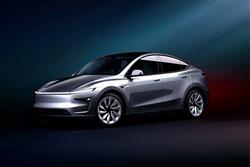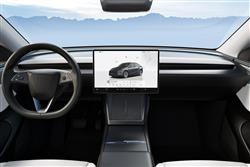Y-NOT (some text hidden) --NONE--
By Jonathan Crouch
Telsa's Model Y has been rejuvenated. Jonathan Crouch drives it.
Ten Second Reviewword count: 59
Over the last few years, the Model Y has defined the way we think of Tesla in Europe, establishing a template for a business-minded electric mid-sized hatch that the mainstream brands are only just getting to grips with. Just as they have, Musk's men have introduced this considerably upgraded 'Project Juniper' design, with sleeker looks and a classier interior.
Backgroundword count: 159
The Model 3 may have been the car that brought Tesla mainstream in worldwide markets but it's hatch stablemate, the Model Y, is the car that's sold in greater numbers since its original launch in 2020. It's been produced in Europe for Europeans at the Tesla Berlin-Brandenburg Gigafactory since 2022 and was the world's best selling car in 2023. Even well into its initial production run, it still managed to be the U.K.'s fifth best seller in 2024. But competition is intensifying in the mid-sized EV segment and going forward, the Model Y will sit in a range also populated by the smaller Tesla Model 2. Time then for a much needed update package known during development as 'Project Juniper'. Many of the changes are similar to those made as part of the 'Project Highland' update visited upon the Model 3 in early 2024. But this updated Y gets much more distinct exterior styling. Let's take a closer look.
Driving Experienceword count: 570
One of the things on Tesla's to-do list with this Model Y's 'Project Juniper' update was to improve ride quality, something that, like others, we criticised about it back in our original test of 2022. Well this enhanced design is still pretty firm, but it's not longer quite as unsettled over poorer surfaces as the original car was. That earlier 'Y' model's refinement also needed looking at, the original version more afflicted with wind noise and tyre roar than it ought to have been. And again, some useful improvements have been made, primarily with new sound-dampening materials and the introduction of acoustic glazing, which Tesla reckons has reduced road noise by 22%, impact noise by 20% and wind noise by 20%. Subjectively, the improvement doesn't feel quite as great as that - journeying quietness still isn't anything like class-leading - but it does at least now match the segment standard. Not all the changes have worked. We weren't that enamoured with the original car's rather lifeless steering and, to try and improve things, Tesla's slowed the rack down from 2 to 2.4 turns lock-to-lock. But it still remains somewhat remote in feel and rather needlessly over-sensitive, whichever of the three provided helm settings you choose ('Light', 'Standard' or 'Heavy'). The drivetrains are much as before, but the EV range figures they generate are usefully enhanced thanks to the improved aerodynamics. The base Standard Range version, which uses a 279bhp rear-mounted motor, has a 63kWh LFP battery that now takes you 311 miles between charges. Most will want the mid-level Long Range Rear-Wheel Drive variant, which gets a gutsier 308bhp rear axle motor to compensate for a larger 83kWh NMC battery capable of taking the car up to 387 miles between charges. The same larger battery also features in the two dual motor derivatives, the Long Range All-Wheel Drive version we tried, which has a combined output of 375bhp; and the top Performance variant, which offers 365bhp and a bespoke high speed drivetrain. Obviously, there's extra weight with the dual motor format, which blunts range a bit; for the ordinary Long Range All-Wheel Drive model, it's quoted at up to 390 miles on 19-inch wheels (327 miles on 20-inch rims). As before, all variants are quite rapid. Both the single motor versions make 60mph in about five and a half seconds, a stat that the standard All-Wheel Drive model improves to 4.1s on the way to the 125mph top speed that all mainstream Model Ys share. The top Performance version manages 0-60mph in 3.3s en route to 155mph and offers 360 miles of range. All of these stats assume you select the faster of the two provided 'Acceleration' modes - 'Sport' (the other is 'Chill'). Belatedly, Tesla's also introduced brake regen settings for our market (branded here as 'Deceleration' modes). Though there are only two ('Reduced' and 'Standard') and they have to be accessed via fiddly centre screen menus, they work well via a brake-by-wire system and give good pedal feel. The other drive change you'll immediately notice is that there's now no gear selection stalk, that functionality having now been moved to the swipe option on the right side of the centre screen you get with other Teslas. Initially, you might find this awkward to use, but you'll get used to it and the system automatically selects backwards and forwards motion when you're manoeuvring at low speeds, which is useful.
To see the full road test text contact us on 0330 0020 227
Pictures (high res disabled)
.jpg)
.jpg)
|
.jpg)
|
.jpg)
| |||
.jpg)
|
.jpg)
|
.jpg)
| |||
.jpg)
|

|
.jpg)
| |||
.jpg)
|
.jpg)
|
.jpg)
| |||

|
Statistics (subset of data only)
Min |
Max |
|
Price: |
£44,990.00 (At 3 Oct 2025, Rear-Wheel Drive) |
£61,990.00 (At 3 Oct 2025) |
Insurance group 1-50: |
37 |
42 |
Max Speed (mph): |
125 (Long Range All-Wheel Drive) |
|
0-62 mph (s): |
5.6 (Rear-Wheel Drive) |
4.6 (Long Range All-Wheel Drive) |
Electric WLTP-Rated Driving Range (miles): |
311 |
|
Length (mm): |
4797 |
|
Width (mm): |
1624 |
|
Height (mm): |
1626 |
|
Boot Capacity (l): |
890 |
|
Power (ps): |
279 (Rear-Wheel Drive) |
375 (Long Range All-Wheel Drive) |
Scoring (subset of scores)
Category: Hybrid, Plug-in, Electric & Hydrogen
| Performance | |
| Handling | |
| Comfort | |
| Space | |
| Styling, Build, Value, Equipment, Depreciation, Handling, Insurance and Total scores are available with our full data feed. | |



